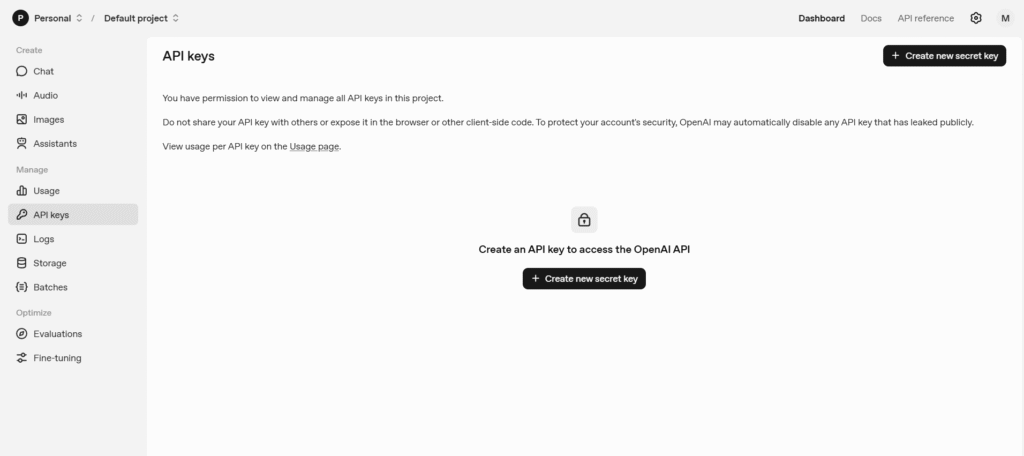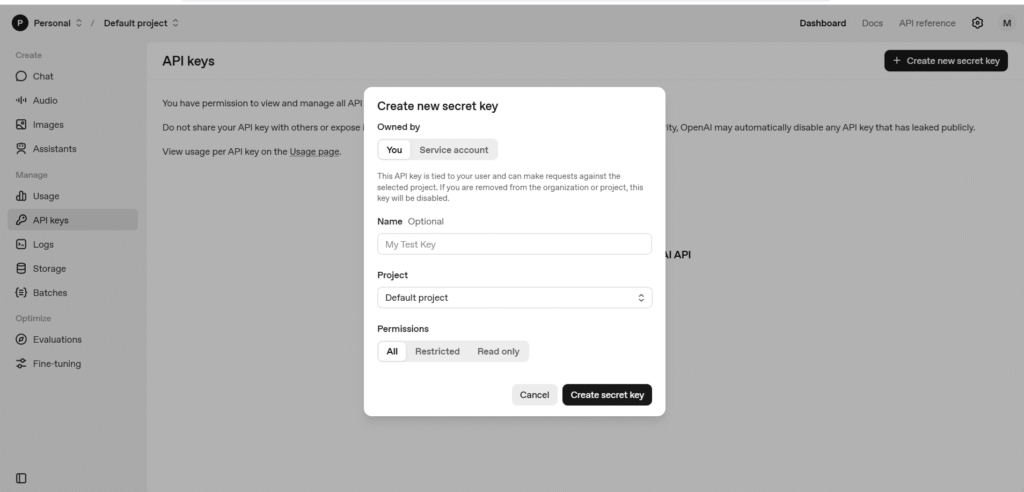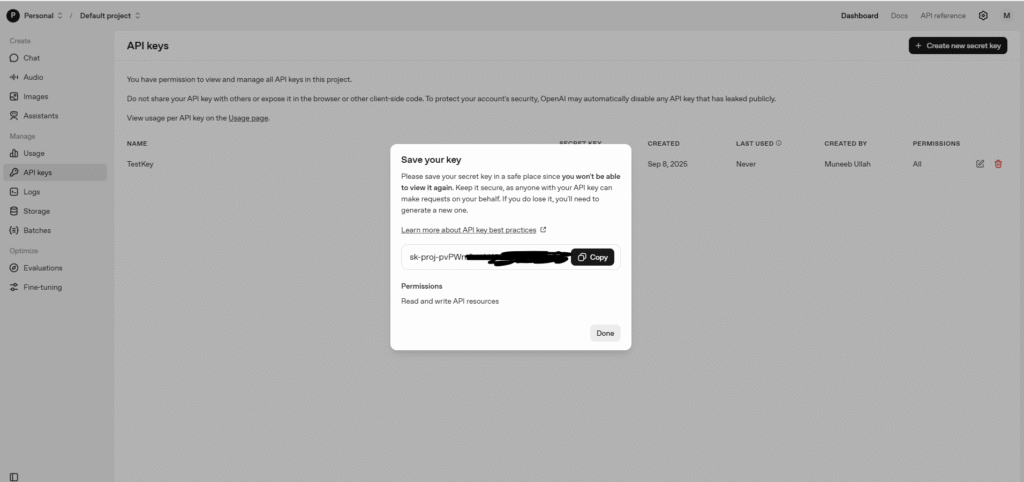1) Create a key
- Open the API Keys page and click Create new secret key. You’ll only see the full value once—copy it somewhere safe. OpenAI Platform
- You authenticate by sending this key as a Bearer token in the
Authorizationheader. OpenAI Platform

“Owned by”: You vs Service account
- You — the key is tied to your user and works only while you retain access to the selected project. Good for local dev and personal experiments.
- Service account — a bot identity that belongs to the project, not a person. Ideal for servers/CI and production since it survives team changes; its default is read/write on the project but you can restrict it. OpenAI Help Center

“Permissions”: All, Read only, Restricted
- All — full access to project APIs (default).
- Read only — list/read metadata only; cannot call write-type endpoints (so it won’t generate content).
- Restricted — pick None / Read / Write per endpoint group (e.g., enable
embeddingsonly, denyassistants). This is the safest production posture. OpenAI Help Center
Common endpoint groups you’ll see:
- Model capabilities:
/v1/chat/completions,/v1/embeddings,/v1/images,/v1/audio,/v1/moderations - Assistants:
/v1/assistants(+ read on/v1/models) - Threads:
/v1/threads(+ read on/v1/models) - Files:
/v1/files - Fine-tuning:
/v1/fine_tuning - Responses API:
/v1/responses

Recommendation: start Restricted, enable only what your service actually needs, and expand permissions only if you hit a 403/permission error. (You can change a key’s permissions later in API Keys settings.) OpenAI Help Center

2) Store it securely (don’t hard-code)
macOS / Linux
echo 'export OPENAI_API_KEY="sk-REDACTED"' >> ~/.bashrc # or ~/.zshrc
source ~/.bashrc
Windows (PowerShell)
setx OPENAI_API_KEY "sk-REDACTED"
.env (local dev)
OPENAI_API_KEY=sk-REDACTED
Keep keys server-side and out of client apps and repos. See OpenAI’s key-safety guidance. OpenAI Help Center
3) Make a quick test call
curl
curl https://api.openai.com/v1/chat/completions \
-H "Authorization: Bearer $OPENAI_API_KEY" \
-H "Content-Type: application/json" \
-d '{
"model": "gpt-4o-mini",
"messages": [{"role":"user","content":"Say hello in 3 words."}]
}'
(Bearer header per auth docs.) OpenAI Platform
Node.js
import OpenAI from "openai";
const client = new OpenAI({ apiKey: process.env.OPENAI_API_KEY });
const res = await client.chat.completions.create({
model: "gpt-4o-mini",
messages: [{ role: "user", content: "Say hello in 3 words." }],
});
console.log(res.choices[0].message.content);
Python
from openai import OpenAI
import os
client = OpenAI(api_key=os.environ["OPENAI_API_KEY"])
resp = client.chat.completions.create(
model="gpt-4o-mini",
messages=[{"role":"user","content":"Say hello in 3 words."}]
)
print(resp.choices[0].message.content)
4) Pick the right combination (cheat-sheet)
| Scenario | Owned by | Permissions | Why |
|---|---|---|---|
| Local dev / quick test | You | Restricted (enable only chat/completions or what you use) | Safer than “All”, easy to delete |
| Production backend / CI | Service account | Restricted (least-privilege) | Survives personnel changes; smaller blast radius OpenAI Help Center |
| Read-only dashboards | Service account (or You) | Read only | Prevents accidental writes/generation |
| Multiple micro-services | Separate service account key per service | Restricted | Limits impact if one key leaks |
5) Projects, usage, and limits
- Keys are scoped to a project; manage them in that project’s settings. OpenAI Platform
- Check your rate limits/tiers and design retries/backoff accordingly. OpenAI Platform+1
6) Backend pattern (the safe way)
- Frontend calls your endpoint (e.g.,
/api/chat). - Your server reads
OPENAI_API_KEYand calls OpenAI. - Return only the model output to the client (never the key).
7) Troubleshooting
- 401 Unauthorized → missing/typo’d key or header; ensure
Authorization: Bearer …matches the docs. OpenAI Platform - 403 Forbidden → permission scope too tight; adjust the key under Restricted to include the endpoint you’re calling. OpenAI Help Center
- 429 Rate limit → you’ve hit your tier; implement backoff and check the rate-limits page. OpenAI Platform
TL;DR
- Create a key, choose Owned by (You for local, Service account for servers). OpenAI Help Center
- Prefer Restricted permissions; open only what you need. OpenAI Help Center
- Authenticate with a Bearer header; keep the key server-side.


Comments